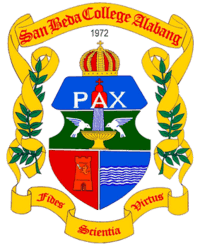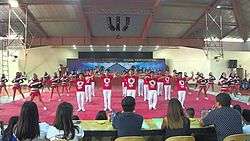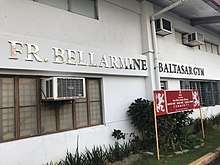San Beda College Alabang
|
Dalubhasaan ng San Beda sa Alabang Colegio de San Beda de Alabang | |
 | |
Former name |
Benedictine Abbey School (1972-1995) St. Benedict College (1995-2004) |
|---|---|
| Motto | Fides, Scientia, et Virtus (Latin) |
Motto in English | Faith, Knowledge, and Virtue |
| Type | Private |
| Established | July 10, 1972 |
Parent institution | San Beda University |
Religious affiliation | Roman Catholic (Benedictine) |
Academic affiliations |
PAASCU BENET (Benedictine Educators' Network) Pilipinas, CBCMMI (Consortium of Benedictine Colleges of Metro Manila, Inc.), ICBE (International Commission on Benedictine Education), FAAP |
| Chancellor | Rt. Rev. Austin P. Cadiz, OSB |
| Principal | Abraham de Castro, Ph.D. |
| Dean |
Andres Ignacio San Mateo Jr.,DBA (CAS) Atty. Ulpiano Sarmiento III (SOL) |
| Rector-President | Very Rev. Dom Clement Ma. Roque, OSB |
| Students | 7,000+ |
| Address |
8 Don Manolo Blvd Alabang Hills Village, Muntinlupa, Philippines 14°25′59″N 121°01′32″E / 14.4331°N 121.0255°ECoordinates: 14°25′59″N 121°01′32″E / 14.4331°N 121.0255°E |
| Language | Filipino, English |
| Colors | Red and White |
| Nickname | Alabang Red Lions |
| Sports | NCAA South, WNCAA, MNCAA |
| Mascot | Red Lion |
| Website | www.sanbeda-alabang.edu.ph/bede |
San Beda College Alabang (Spanish: Colegio de San Beda de Alabang) and (Filipino: Dalubhasaan ng San Beda sa Alabang) is an autonomous college affiliated with San Beda University, a private Roman Catholic university run by the Benedictine monks in the Philippines. It is located in Alabang in Muntinlupa, Metro Manila.
History
Origin
The Benedictine monks came to the Philippines on September 12, 1895. They started missionary work in Surigao in 1896. Rev. José Deas Y. Villar, OSB founded the Benedictine community in Mindanao. A few years later, after the monks’ Mindanao mission, the Benedictine community transferred their residence and apostolate to Balmes Street in Quiapo, Manila.[1]
Under the leadership of Fr. Juan Sabater, OSB, El Colegio de San Beda (now San Beda University) was established in 1901 in Mendiola, Manila.[2]
Growing years
Restiveness marked the late 1960s and the early 1970s, which led to the decision by the Benedictine monks to establish another campus outside Manila. They decided on Alabang in Muntinlupa as the site of the new campus. A modern edifice was constructed in 1972 on a nine and a half hectare lot inside the Alabang Hills Village. On July 10, 1972, Benedictine Abbey School (BAS) opened its doors to 78 preschool boys and girls. Fr. Roberto de Jesus, OSB, who was the first Rector, supervised the growing years of the new institution. BAS opened its high school department in 1977.[3]
Both elementary and high school departments later gained accreditation from the Philippine Accrediting Association of Schools, Colleges and Universities (PAASCU).
From Benedictine Abbey School to St. Benedict College


Fr. Bellarmine R. Baltasar, OSB, who served as Rector for almost a decade, introduced the establishment of the tertiary level that opened on their centennial anniversary in the Philippines. The school was renamed St. Benedict College on June 5, 1995. Along with this came the construction of the Fr. Bellarmine Baltasar Gym (then St. Benedict College Gym).[4]
Under the leadership of Fr. Tarcisio H. Narciso, OSB, Rector, the college department initially offered mostly business oriented courses. The department welcomed 208 students and 15 faculty members recruited from other colleges and universities and from the roster of the San Beda University high school and grade school faculty. In the succeeding years, the college opened additional courses that catered to arts, humanities and other sciences. The St. Bede Hall (college building) was constructed in March 1996 and inaugurated on July 1, 1997 in time for the institution’s silver jubilee.
In 2001, Fr. Aloysius A. Maranan, OSB, Rector and concurrent Dean, renamed the college department College of Arts & Sciences. He focused on revitalizing the CAS through extensive operational and academic policies, curriculum adjustments, administrator overhauls. and faculty development.
From St. Benedict College to San Beda College Alabang

| Rector - Presidents of San Beda College Alabang |
|
1972–79 – Roberto De Jesus |
On September 7, 2004, after 32 years since its establishment, the college made the decision to adopt the secondary name of the institution as its official name; San Beda College Alabang. Fr. Anscar Chupungco, OSB, Rector-President led the decision in response to the growing demand of the institute's stakeholders. [5]
Fr. Chupungco led the expansion of the higher education departments by opening the School of Law in 2005. It began as an extension of San Beda University in Manila until the new department became a separate entity in 2009.[6]
With the assumption of Dom Clement Ma. H. Roque, OSB as the eighth Rector-President in 2008 and his re-election in 2010, the school's efforts towards PAASCU accreditation were placed. Construction of new facilities like the St. Maur Building for the School of Law were accomplished at the same time with the upgrading of sports facilities.
In 2013, Rev. Fr. Anselm M. Manalastas, OSB was installed as the ninth rector, which occurred after the passing of its seventh rector-president. On July 2, 2015, SBCA inaugurated its Graduate School with its initial offering of a degree leading to Master in Business Administration.[7]
Responding to the government’s mandate of an expanded basic education program, the school began preparations for the transition to the new curriculum. A task force on Senior High was created by Rev. Fr. Anselm M. Manalastas, OSB in 2013. In April 2016, the Board of Trustees approved the establishment of the Senior High School Department as a separate unit from the IBED (K-10) department. The move was in line with the strategic thrust to position our SHS as a college preparatory program and align it with the course offerings of the CAS.
Dom Clement Ma. H. Roque, OSB, Rector-President led the ground-breaking of the SHS building, named Our Lady of Montserrat Hall on May 14, 2016 together with the distinguished members of the Board of Trustees which opened on January 20, 2018.
Academics
San Beda College Alabang School of Law
The San Beda School of Law in Alabang was established in 2004 and has been declared autonomous from the San Beda Law School in Mendiola, with lawyer Ulpiano P. Sarmiento III as its first dean. Among San Beda Alabang's faculty members are former Philippine senator Rene Saguisag, Rene Sarmiento, a former commissioner of the Philippines' Commission on Elections, and the lawyer brothers Sigfrid and Raymond Fortun.[8]
Center for Performing Arts
San Beda College Alabang established the Center for Performing Arts in 2007. The center offers short courses in theatre, drama, acting, dance, and music.
References
- ↑ "100 Years of Benedictine Education San Beda College 1901-2001". San Beda College.
|access-date=requires|url=(help) - ↑ "Origins of SBC". The Bedan Herald. Retrieved 7 February 2018.
- ↑ "Origins of SBCA". The Bedan Herald. Retrieved 7 February 2018.
- ↑ "Fr. Baltasar's legacy". The Junior Bedan. January 2015.
- ↑ The Bedan July 2004: St. Bene is now San Beda Alabang
- ↑ "San Beda Alabang School of Law's Legal Aid Bureau: A first in the South". GMA News. Retrieved 11 March 2013.
- ↑ Legaspi, Amita (January 9, 2013). "Former San Beda rector dies from heart attack". GMA News. Retrieved 12 December 2017.
- ↑ "School of Law Faculty". Retrieved 7 February 2018.